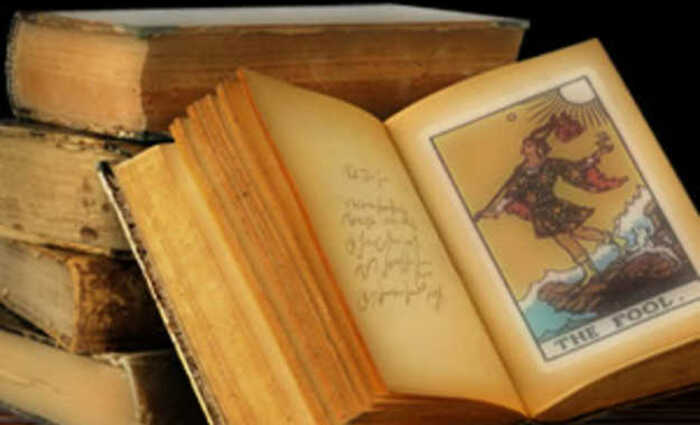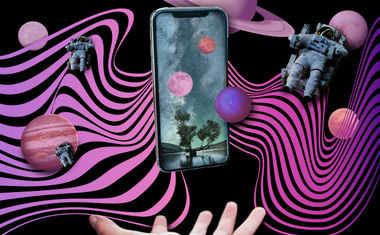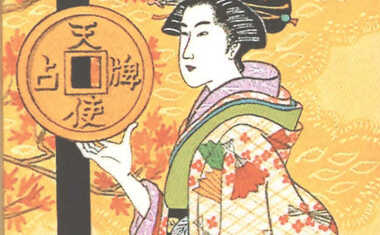
Tarot Imagery
Discover all of the different types of imagery in the Tarot deck
Part VIII: Tarot imagery
In an earlier section, we briefly examined the hypothesis that the Tarot symbols are the product of, or were directly influenced by, Gnosticism in the form of Catharism. The answer was clearly No! A scholarly examination of Catharism uncovered doctrines that are in direct conflict with a number of the Tarot symbols, as well as with concept of any material expression of dualist dogma.
In this Section, we return to the Tarot symbols with a new hypothesis, a new question: Is there any internal evidence in the Tarot symbols that indicates that they were influenced by the transformed Catharism as it existed in 15th century Italy, possibly in the Confraternities? If there is some/any evidence, is the evidence strong enough to indicate a dominant influence? Or simply another influence that was synthesized with the many other influences that are documented in O'Neill (1986)? The purpose is not to prove or disprove an influence. The purpose is simply to examine the images objectively and see if there are any indications of heretical influence. For this exploration, we will narrow our attention on the oldest extant cards-- the 15th and early 16th century hand-painted and woodblock cards illustrated in Kaplan, Volume One (1978) and Volume Two (1986).
Fool
In one sense, the 15th century viewer, immersed in the Humanism and Neoplatonism of the Renaissance, would have seen the Fool as the "lowest estate of man" (Lambert, 1977). But, at the same time, the religious mindset of the times might have seen this image of wandering and poverty as the highest state of the reformed man--the man on the verge of the new age--the new saint. Basically, what motivated the popular response to the early European heretics, to the Cathar perfecti, and to the Spiritual Franciscan was their rejection of worldly values and their commitment to apostolic poverty. One might even speculate that the harassing "dogs" that appear in later decks are a ribald reference to the Inquisition and its persecution of the Cathar and Franciscan heretics.
The images on the woodcut decks (Kaplan II:276, 286) might support this type of dual interpretation because the Fool in these decks can be taken as an earnest traveler. But the hand-painted decks (Kaplan I:65, 112, 117) do not support the dual interpretation. Goiters and exposed genitals are hardly compatible with the chaste Perfecti or Franciscan!
Bagatto
The same type of ambiguity attaches to the Bagatto. The traveling montebank/trickster might be seen as the next higher "estate of man" in a Humanist/Neoplatonic mindset. But the itinerant preacher (heretical/heterodox/orthodox) also employed simple tricks to attract a crowd and traveled in the disguise of salesman. However, the images on the early decks, whether hand-painted or woodblock (Kaplan I:65, 117, 131; II:274, 286) don't support this dual interpretation--they all show an entertainer/trickster with no hint of an underlying spiritual intent. The evidence indicates that the concept of the Bagatto as an itinerant preacher was not part of the original concept.
Papess
The Papess card is often offered by occultists as proof-positive of the esoteric origins of the Tarot--the two pillars representing the two pillars of Solomon's Temple and clear evidence of Gnostic dualism. However, we saw in an earlier section that the Cathari had dismissed the description of the Temple in the Old Testament as a work of the Devil. A far more plausible source is the Figurae of Joachim (Reeves and Hirsch-Reich, 1972) who drew two pillars as a symbol of the Old/New Testament and the Secular/Ecclesiatical Authority. The dualism is therefore more likely Neoplatonic than Gnostic.
If the source for the symbolism of the dual pillars is Joachim, then we are faced with a real dilemma. Joachimism was influential in the 15th century, irrespective of any direct connection to heresy. But it is also true that the 15th century knew Joachimism only through the popular commentaries of the Spiritual Franciscans. Therefore, any time we trace symbolism to Joachimism, we cannot definitely confirm a connection to heresy--nor can we dismiss it off-handedly.
But, in a very real sense, the concerns over the interpretation of the symbolism of the dual pillars are of academic interest only. This is because of the evidence in the early cards themselves--there isn't a hint of pillars on any of them! So the evidence indicates that the dual pillars wasn't part of the original concept.
But beyond the irrelevant detail of the pillars, the Papess card admits of a number of possible interpretations. Two of the possible interpretations are relevant here. The Tarot Papess may represent a Sibyl--a pagan prophetess. If one accepts this interpretation, then we are reconnected to the apocalyptic view of history and Joachimism. But, once again, a reference to Joachim neither confirms or negates a tie to Catharism.
A second potential interpretation of the Papess was offered by Moakley (1966). She suggests that the Papess represents the heretic Maifreda who was actually elected Pope by a small sect of Guglielminites (Newman, 1995). If one accepts Moakley's interpretation, then the Papess card does indeed indicate a tie to heresy. However, we need to be careful-- Maifreda belonged to an heretical sect--but it was not a Cathar sect and had no ties to Catharism. Whether one accepts Moakley's concept is a matter of interpretation left to the reader.
Empress
In many respects, the symbol of the Empress is more enigmatic than the Papess. There was no prominent Empress at the time and it is a stretch to find any heretical implications in the symbol. About the best I can offer is that the two symbols of temporal rule are NOT Count/Countess or King/Queen as they might be if the cards had originated in Provence. The symbols are not Duke/Duchess as they should be if they referred to a specific ruler of an Italian city-state.
In the early thirteenth century, the Italian patrons of the Cathari belonged primarily to the Ghibelline political party. This party advocated the return of the Holy Roman Emperor as ruler of Italy--largely as a buffer against the growing political power of the Papacy. So there is a slim chance that the Empress/Emperor symbols make reference to this political theme.
However, it seems far more likely that the Papess/Pope, Empress/Emperor are simply symbols of female/male, spiritual/temporal authority. As we have seen, this sexual duality does not have its source in Catharism which regarded gender as an illusion. The temporal/spiritual duality, however, might have its source in Joachimism where this duality was given prominence in the dual pillars of Church and State (Reeves and Hirsch-Reich, 1972).
Emperor/Pope
A stronger case can be made for the Joachimite origins of the Emperor and Pope symbols. The transition to the new Age of the Spirit would be signaled by the emergence of a "World Emperor and Angelic Pope" (Reeves, 1976) who would establish a new order following the destruction of the evil Anti-Christ ruler and pope. An example of the iconography associated with the "World Emperor" can be found in the Frontispiece of McGinn (1979). The woodblock print is from Methodius of Olympus "Revelations" Basel 1516 and shows the Emperor dedicating crown and orb to the Crucified Christ. The Ghibelline expectation that the World Emperor would be the Holy Roman Emperor may be implied by the heraldry of the Black Eagle on early hand-painted cards (Kaplan I:67, 88, 99, 103) and on the woodblock sheet from Milan (Kaplan II:286).
Lovers
The Lovers symbol is diametrically opposed to Cathar doctrine. Gender and sexual attraction are Satanic traps. This would not have been much different in the 15th century since the transformed versions of Catharism were still based on asceticism and chastity. The Lovers symbol seems simply to refer to the role of human love in the self-development of the individual. Following the hypothesis of Moakley (1966), the immediate source is probably the "Triumph of Love" from Petrarch's epic poem, "I Trionfi."
Chariot
The Chariot card carries no implication of heresy. It's likely the image is also inspired by Petrarch's "I Trionfi" in which the "Triumph of Chastity" follows the "Triumph of Love." Two of the early hand-painted decks hint at this source by showing a noble woman on a vehicle that looks more like a parade float than a war chariot (Kaplan I:68, 101). Two of the partial cards (Kaplan I:125, II:276) also suggest the Triumph of Love. The others suggest a chariot in a victory procession. None of those variants seems to carry any obvious heretical content.
Justice/Fortitude/Temperance
The presence of the three virtues argues strongly for a basically orthodox source for the Tarot images. There is nothing even vaguely heretical here. The absence of the fourth Moral Virtue, Prudence, may hint at an esoteric influence since the three virtues correspond to the three Pythagorean virtues. These were known in the late Middle Ages through Iamblicus' "Life of Pythagoras." But that association would suggest a Neopythagorean or Neoplatonic influence rather than heresy.
Hermit
The majority of the early cards suggest the image of Father Time. Panofsky (1939) devotes an entire chapter to the rich iconology of this symbol in Medieval and Renaissance art and explicitly draws the connection with Petrarch's "Triumph of Time" which is a possible inspiration for the image. One of the woodblock images (Kaplan I:128) is clearly Father Time with the typical wings and crutches. For most of the others, the key feature is the hourglass (Kaplan I:68, 114, 130).
But since the card was later named "Hermit", the image might have had additional connotations to the Renaissance viewer. Perhaps the reference is to Joachim who distinguishes the secular preacher from those who "live the hermit life on the mountain top" (Reeves, 1976). The mountain top appears in one early deck (Kaplan I:114). The reference might also be to the small groups of Fraticelli hermits who still existed in 15th century Italy.
Of immediate relevance to our topic, the Hermit might also refer to the Cathar Perfecti or their replacement, the Spiritual Franciscans. However, the name fits better than the images. The early images are relatively well-dressed (Kaplan I:68, 114; II:273) compared to the tattered habits of the ascetics. Eisenbichler (1991) shows an image of a confraternity member in black robes and carrying a lantern (Figure 17). This resembles the one early image that shows a lantern, rather than an hourglass (Kaplan II:273). But that Tarot image shows the man's face rather than the conical hood covering the confraternity brother, so the early Tarot images really don't support the hypothesis of heretical influence on this symbol, in spite of the suggestiveness of the later title.
Wheel
The Wheel of Fortune image was a common allegorical image in Europe throughout the Middle Ages. The immediate inspiration is likely to be Petrarch's "Triumph of Fortune". I don't see anything about the early images that suggests heretical connotations.
Hanged Man
Moakley (1966) suggested that the Hanged Man image was a "shame drawing". She documents that traitors were often represented in this manner in wall drawings. It is conceivable that some would have seen the image as St. Peter, who was crucified in the inverted position, but that is a stretch since the Tarot image really doesn't fit the description in the apocryphal Acts of Peter (James, 1924). Nevertheless, we cannot simply dismiss the possibility since Latin manuscripts of this work with its Gnostic connotations did exist in Europe. The iconography might have entered the Renaissance mindset through Dante. But that possibility is quite complex and will have to await the following chapter.
The simplest interpretation would seem to be allegorical--the need to reverse material values in order to progress in self-development. This would explain why the image is shown holding bags of money on two of the early cards (Kaplan I:114, 130). This theme may be an obscure reference to the reversal of secular values and the ascetic poverty of the Cathari and Spiritual Franciscans, but it could also be a perfectly orthodox reference as well.
Apocalytic tradition in Western art
Many of the remaining cards in the Tarot share imagery with the Western artistic tradition associated with the book of Revelation. This tradition is unfamiliar to the Tarot community, and now seems a convenient point to interrupt our analysis and introduce it. Betts (1998) introduced the idea that the Tarot is based on an apocalyptic vision and the following may be seen as a followup on his original insight.
The book of Revelation records a series of prophetic visions, in the tradition of Old Testament prophets such as Ezekial. The visual imagery inspired Western Christian artists as early as the fourth century. The result was an orthodox artistic tradition that was pervasive in Christian Europe. Having investigated this tradition, I have personally become convinced beyond a shadow of doubt that some of the Tarot symbols are based on this tradition. For example, the Emperor/Pope symbols, with their potential connection to the World Emperor and Angelic Pope of Joachimism, frequently appear together in this tradition.
James (1931) points out that the beginnings of the artistic tradition are found in mosaics of Roman Churches of the 4th century, e.g., St. Pudentiana. He documents ten illustrated manuscripts of Revelation between the 8th and 12th century. The manuscripts are from Italy, then Spain, then Germany. Perhaps inspired by the popularity of Joachim's apocalyptic vision, there was a great increase in the number of illustrated manuscripts in the 13th to 15th centuries. James (1931) documents ninety-two manuscripts and admits that this is far from a complete list. Manuscripts from this active period are most abundant in England and Northern France.
These traditional images do not only appear in illustrated manuscripts. They appear in mosaics, stained glass, tapestries, frescoes, bas-reliefs, oil paintings, and almost every other conceivable medium. A remarkable book by van der Meer (1978) contains 228 plates with illustrative examples. He provides a map of the location of significant examples and the geographic spread is impressive: British Isles--15, Scandinavia/Russia--7, Germany--36, Austria--7, Czechoslovakia--2, Low Countries--11, France--78, Spain/Portugal--28, Italy and Balkans-- 34. So the tradition was pervasive throughout Europe and the imagery appears in both religious and secular art (Emmerson, 1992).
We will point out the Tarot symbols which appear to draw on this artistic tradition as we go through the rest of the cards. But by way of introduction, we can take the panorama that van der Meer (1978) chose as his Frontispiece. It shows Christ enthroned in a Mandalora (here only partial) and surrounded by the four beasts (here represented by angels). This immediately calls to mind the later World card. Christ is illustrated with a book in his lap and his hand extended in the familiar papal blessing seen in the Tarot Pope image. In the background are angels emerging from clouds blowing elongated trumpets, much as they appear on the Judgment card. The background also shows the "New Jerusalem" which is found on the early World cards. The image is taken from a French Book of Hours c1410. This panorama suggests significant overlap between Tarot imagery and this pervasive Apocalyptic art tradition.
The familiar image of the World card as a triumphant figure in a mandalora surrounded by the four beasts doesn't actually appear in any of the early cards. Nevertheless, it will serve to illustrate how tightly the later Tarot image might be connected with the Apocalyptic tradition. James (1931) documents that Leo I, elected 440 AD, placed a mosaic of Christ enthroned in a mandalora with the four beasts in St. Peter's in Rome. The mosaic is long gone, but it illustrates the great age of this icon in orthodox Christianity.
The popularity and pervasiveness of this image of the enthroned Christ can be seen in the examples documented in van der Meer (1978). He provides illustrations from the 6th century, c827, c840, c869, 1076, c1110, c1150, c1250, c1350, 1400, and a woodblock print from 1420-1435. In an appendix, van der Meer (1978) provides a list of the known examples of Apocalyptic imagery. He apologizes for not including all of the examples of the enthroned Christ as that "would make the list impractically long." Since he then proceeds to list several hundred examples, this specific image must have been very widespread indeed!
The important point is that apocalyptic imagery was not a rare phenomenon, hidden in esoteric manuscripts and only seen by a few. This imagery was common in churches and popular prayerbooks by the early 15th century. "The images were so common that the viewer would recognize them immediately" (Camille, 1992).
This apocalyptic tradition antedates Catharism and is totally orthodox. The only remote taint of heresy comes from the resurgence of popularity of the imagery in the 13th to 15th century. The resurgence was likely motivated by the popularization of Joachim by the commentaries written by the Spiritual Franciscans. However, this was simply a resurgence of the older orthodox imagery--the imagery itself was not affected in any way by Joachimism.
The earliest woodblock-printed illustrated Apocalypses appear in second quarter of the 15th century and were probably produced by the heretical Brethren of the Common Life (Klein, 1992). We have six examples of these woodblock books from the 15th century (Camille, 1992), so they are likely to have been quite popular. These were primarily picture-books (James, 1931), intended for barely literate readers. So once again, the resemblance of the Tarot symbols to the orthodox apocalyptic tradition cannot be taken as evidence of an heretical source for the Tarot. But we also cannot dismiss off-handedly the suggestion that these perfectly orthodox images might have influenced the Tarot through the fringe Joachimite heretics who were responsible for the resurgence of the traditional imagery.
It is important to point out that the apocalyptic imagery is conspicuous in a number of the Tarot symbols--but not all of the Tarot symbols. So although the evidence indicates an influence on the Tarot, it does not indicate that this is the sole or even dominant source of the Tarot imagery. On the other side of the coin, the Tarot images leave out some of the most conspicuous elements of the traditional imagery, e.g., seven candlesticks, Christ with a sword emerging from his mouth, the devil as a dragon, four horsemen, twenty-four elders, etc. So the evidence does not support the hypothesis that the Tarot is simply another example of the traditional representation of the book of Revelation. The reasonable conclusion seem to be that this artistic tradition was another of the sources of images for the synthesis in the Tarot symbols.
There are two other minor points that must be made before we proceed. First, the woodblock books demonstrate that some of the Tarot images were quite familiar to the printers that produced the early woodblock decks. Second, scholars such as James (1931) and Camille (1992) point out that the illustrations were intended to serve as meditation or contemplation aids. So designers of images similar to the Tarot saw the imagery as something more than allegory and intended the imagery to serve a spiritual and educational purpose as well. When the gamesters recognized an image from their prayer book, some at least must have seen the images as something more than random illustrations for a card game.
Death
The image of Death as skeleton with scythe is almost universal in Christian art and has a direct tie to Revelation 6:8, "And I saw, and behold a pale horse: and he that sat upon him, his name was Death." The most common representation in the early cards shows Death mounted (Kaplan I:90, 14, 125, 129, 131; II:272). As one of the four horsemen, Death is a very common element of the Apocalyptic artistic tradition. For example, van der Meer (1978, plate 182) shows a woodcut, very similar to the Tarot images, with the skeleton on horseback and the fallen evil ruler and pope. The fallen figures also appear on three of the early cards (Kaplan I:90, 114,131). A similar concept appears in heretical Joachimite commentaries where the AntiChrist is envisioned as being vanquished by one of the four horseman (Douie, 1932).
The skeleton/scythe also appears in images of Petrarch's "Triumph of Death" (Panofsky, 1939). In this case, the image is not on horseback and probably explains why two of the early cards (Kaplan I:71, 104) show Death unmounted. So, the Death image appears to be a lily-white orthodox image with known and documented contemporary sources. The only hint of heresy is through the Joachimite stimulation of the Apocalyptic tradition.
Devil
The Devil is an important symbol in human religion. The existence of evil seems to require a causal principle and this cause becomes personified as one pole of an archetypic duality. The image of the Devil certainly appears in the Apocalyptic tradition (van der Meer 1978) although the typical representation shows the dragon attacking the woman and child or angels thrusting the dragon into hell. However, James (1931) describes a 9th century manuscript that has a seated and horned devil holding the end of a chain controlling five people chained by the hand. This appears to be related to later Tarot Devils, but the chain and seated posture do not appear in any of the early woodblock decks (the Devil never appears in any of the hand painted decks).
Because the Devil is such an important figure in religious imagery, it appears in both Cathar and orthodox theology. So we cannot dismiss the possibility of a Cathar influence in this card. But neither can we confirm it because the Devil is a perfectly orthodox symbol as well! So this ambiguity continues to plague our investigation.
Tower
The tower image is one of the most consistent in the early decks. They all show towers crumbling, falling or in flame (Kaplan I:115, 125, 129, 131; II: 272, 276, 286). The iconography of the destruction of the Tower has a long history in the Judeo-Christian tradition. For example, in Judges 8:18, Gideon marks his great victory by destroying the Tower of Penuel. The image appears in the Prophets, for example Ezekial 26:4, "They will destroy the walls of Tyre, [and] they will demolish her towers," and Zephaniah 3:6, "I have wiped out nations, their corner towers lie in ruins."
The destruction of the Tower is commonly represented in the Apocryphal tradition (e.g., van der Meer 1978, plates 143, 151) based on Revelations 14:8 and 18:10. James (1931) describes a manuscript of 894 AD that depicts the fall of Babylon. The cover illustration of McGinn (1979) also shows the crumbling tower. The Apocryphal tradition probably inspired the use of this image in Petrarch's Sonnet 137 "Covetous Babylon...And its high towers, enemies of heaven, and those who live in them will be burned inside and out" (McGinn, 1979).
The image also appears in the beliefs of the heretics. The Beguines believed that the church of Rome was Babylon, the great Harlot of Revelations (17:5), and would be destroyed utterly and catastrophically before the beginning of the new Age of the Spirit (Emmerson, 1992). Later decks that name this card "House of God" may be referring to this heretical concept. Interestingly, the Tower card only appears in one of the early hand-painted decks (Kaplin I:115). It is a stretch, but was this card possibly omitted from the nobles' decks because it was seen as heretical?
The Tower card, like the Devil, leaves us in an ambiguous position. The image was used by both heretical and orthodox Christians. The appearance of the image in the Tarot could be influenced by Joachim-transformed Catharism. But the image also appears in totally orthodox contexts as a part of the Apocalyptic tradition.
Star/Moon/Sun
These three cards admit of a simple, orthodox interpretation. They reflect the Renaissance fascination with astrology (e.g., Allen, 1941). This seems affirmed by the early cards that show astrologers taking measurements (Kaplan I:117, 129). They may also be influenced by the Neoplatonic cosmology in which star, moon, and sun represent three of the spheres surrounding the earth. They also reflect a Humanist contribution since two early Sun cards show the face of Apollo (Kaplan I:73, II:273). However, they also appear as incidental background images in the Apocalyptic tradition (e.g., van der Meer, 1978, plate 143). Joachim used star, moon, and sun as a simile for his three historical periods (Douie, 1932).
There is considerable variation in the early representations of these cards. Some show just the heavenly body (Kaplan I:130f; II:273). Some show a woman or man or cherub holding up the image (Kaplan I:72f, 99, 104; II:274). Others show more elaborate scenes, including the Milanese sheet (Kaplan II:286) which resembles the images in later Tarot decks. However, I am at a loss to find anything whatever that suggests a specifically Cathar influence anywhere in this imagery.
Angel
The image of the angel(s) trumpeting the resurrection of the dead and the final judgment is an integral part of the Apocalyptic tradition that goes back at least to the 9th century (James, 1931). The image appears throughout this orthodox artistic tradition (van der Meer, 1978).
As we pointed out in an earlier section, the Catholic doctrine of the resurrection of the body was flatly rejected by Catharism. Without exception, the early cards show people rising from graves or tombs (Kaplan I:71, 90, 116, 128, 130; II:273). So on the basis of the evidence, we must reject the hypothesis that the Tarot is a Cathar product or was directly influenced by the original doctrine.
However, the final judgment and the resurrection of the body was still an important element of the Joachimite tradition. These events marked the end of the third and final age of history (Douie, 1932). As such, the image on the early cards could be influenced by the Catharism transformed by the Spiritual Franciscans and Joachimism. However, as usual, the image was shared with orthodox theology and can be viewed as having no connection to the dualist heresies.
World
The early cards show the "New Jerusalem" in a circle or wreath with two cherubs (Kaplan I:73, 104), a woman above (Kaplan I:92, 109, 116) or an angel (Kaplan I:117, 130; II:273) or a figure that appears to be Mercury (Kaplan I:128). The imagery comes from Revelation, and I trust the reader will not be scandalized to learn that it begins the 21st Chapter: "Then I saw a new heaven and a new earth...I saw the holy city and the new Jerusalem, coming down from God out of the heaven, as beautiful as a bride dressed for her husband."
This image of the New Jerusalem is an integral part of the Apocalyptic tradition with one example (van der Meer, 1978, plate 45) that is older than 827 AD and a manuscript example (James, 1931) from 894 AD. And, as usual this vision from Revelation was also a part of the Joachimite vision.
Summary
To summarize our laborious journey through the symbolism of the 15th and 16th century cards--the evidence is ambiguous. The images that might suggest a Joachimism inspired by the Spiritual Franciscans also belong to a perfectly orthodox and ancient artistic tradition. There is nothing here to demonstrate an heretical input. There is nothing here to refute an heretical input.
References
Allen, D. C. 1941. The Star-Crossed Renaissance. Duke University Press. rptd. 1973. Octagon Books, NY.
Betts, T. 1998. Tarot and the Millenium. New Perspective Media, Rancho Palos Verdes, CA.
Camille, M. 1992. "Visonary Perception and Images of the Apocalypse in the Later Middle Ages." 276-289 in Emmerson, R. K. and B. McGinn, eds. The Apocalypse in the Middle Ages. Cornell University Press, Ithaca, NY.
Douie, D. L. 1932. The Nature and Effect of the Heresy of the Fraticelli. University Press, Manchester. AMS reprint, 1978.
Eisenbichler, K., ed. 1991. Crossing the Boundaries. Medieval Institute Publications, Western Michigan University, Kalamazoo.
Emmerson, R. K. 1992. "Introduction: The Apocalypse in Medieval Culture." 294-332. Emmerson, R. K. and B. McGinn, eds. The Apocalypse in the Middle Ages. Cornell University Press, Ithaca, NY.
James, M. R. 1924. The Apocryphal New Testament. Oxford Univesity Press. rptd 1975).
James, M. R. 1931. The Apocalypse in Art. Oxford University Press, London.
Kaplan, S. R. 1978. The Encyclopedia of the Tarot, Volume One. U. S. Games Systems, NY.
Kaplan, S. R. 1986. The Encyclopedia of the Tarot, Volume Two. U. S. Games Systems, NY.
Klein, P. K. 1992. "Introduction: The Apocalypse in Medieval Art." 159-199. Emmerson, R. K. and B. McGinn, eds. The Apocalypse in the Middle Ages. Cornell University Press, Ithaca, NY.
Lambert, M. 1977. Medieval Heresy. Blackwell, Oxford. 2nd ed. 1992. rptd. 1997.
McGinn, B. 1979. Visions of the End. Columbia University Press, NY. 2nd ed. 1998.
Moakley, G. 1966. The Tarot Cards. N. Y. Public Library, NY.
Newman, B. 1995. From Virile Woman to WomanChrist. University of Pennsylvania Press, Philadelphia.
O'Neill, R. V. 1986. Tarot Symbolism. Fairway press, Lima, OH.
Panofsky, E. 1939. Studies in Iconology: Humanistic Themes in the Art of the Renaissance. Oxford University Press, Oxford. Rptd. 1972. Westview Press, Boulder, CO.
Reeves, M. 1976. Joachim of Fiore and the Prophetic Future. SPCK, London. 1999 ed. Suton, Gloucestershire. abbr. JF.
Reeves, M. and B. Hirsch-Reich. 1972. The Figurae of Joachim of Fiore. Oxford University Press, Clarendon Press.
van der Meer, F. 1978. Apocalypse: Visions from the Book of Revelation in Western Art. Alpine Fine Arts Collection, NY.



